Part VIII:
Four More Films Co-directed by
Edwin Stanton Porter & Wallace McCutcheon
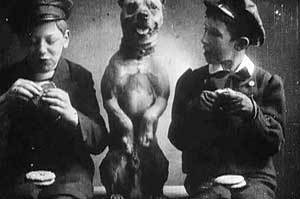 Porter & McCutcheon directed one of the more extreme "bad boys" comedy is Three Terrible Kids (1906). These bad boys are sufficiently bad, rather than just amusing, that public criticism of the poor role models provided by motion pictures erupted among moral crusaders, & would never let up to this very day.
Porter & McCutcheon directed one of the more extreme "bad boys" comedy is Three Terrible Kids (1906). These bad boys are sufficiently bad, rather than just amusing, that public criticism of the poor role models provided by motion pictures erupted among moral crusaders, & would never let up to this very day.
There are only two terrible kids really, the third being their bulldog, played by the first dog movie star, Mannie.
The two boys pester a woman they encounter in the street because she has a puppy they want to steal. She manages to fend them off just before her husband or beau arrives. He helps her put the puppy inside her satchel or purse. When they set the satchel down for a moment, Mannie quietly crawls into the picture & grabs it.
We'll never see that puppy again so the boys must've gotten tired of it right away, & it probably died a miserable life without its owner.
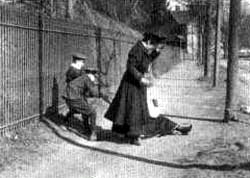 We next see Mannie chasing after a Chinese guy with a pigtail. The dog leaps up the man's back, & latches onto the pigtail, pulling him to the ground. The boys laugh & laugh, as it's only a stinking Chinaman who's being mauled after all. We next see Mannie chasing after a Chinese guy with a pigtail. The dog leaps up the man's back, & latches onto the pigtail, pulling him to the ground. The boys laugh & laugh, as it's only a stinking Chinaman who's being mauled after all.
They then harrass an honest laborer who is pasting up posters on a wall. With the dog's assistance they terrorize the man & knock him off his ladder, running off before they know whether or not the guy broke his back.
They then use Mannie & his leash to cause two pedestrian women to fall down. The boys end up having to flee all the people they brought harm to, & the police besides. One nutty sequence has the group of people chasing the boys by rolling uphill on their sides; what that's all about I have no ideal.
The terrible boys & their dog continue their flight. They are too swift for anyone to have a chance of catching them, until a cop leaps out in front of them & finally they are hauled away & locked inside a paddy wagon. Mannie however, alone in the street, leaps at the door handle of the departing paddy wagon, & liberates the boys.
Eventually they'll grow up & serve hard time in Sing Sing, but on the present day at least, they're free to rob & injure people for a while longer, & it's just so funny.
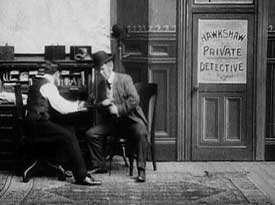 Getting the Evidence: Showing the Trials & Tribulations of a Private Detective (1907) sounds like it might be a crime film, but it's a comedy. The sign painted on his door's window says "Hawkshaw Private Detective."
Getting the Evidence: Showing the Trials & Tribulations of a Private Detective (1907) sounds like it might be a crime film, but it's a comedy. The sign painted on his door's window says "Hawkshaw Private Detective."
The private eye (Paul Panzer) smokes a mersham pipe, obviously a Holmes fan. A nervous client arrives, pacing the floor, demanding the detective get photographic evidence that his wife is cheating on him.
The detective sets out to get evidence against the man's wife. He lies in wait near their house, ready to take pictures. One picture is spoiled by the gardener who scoops up the lurking detective in a wheelbarrow. In the next try, the woman's sweetheart just runs the detective down. At a park's outdoor cafe, her sweetheart gives him the boot.
Trading clothing with the black waiter at the outdoor cafe, our detective blackens his face to get close to the table. But when he lifts his camera, he gets seltzer-sprayed in the face.
He next stalks them on a golf course & gets wacked in the face with a golfball then gets his camera mashed to bits with a golfclub.
Slapstick scenarios continue & many cameras are destroyed throughout his inept attempts to photograph the woman & her beau in any compromising situation.
When the detective finally has his shot of them on the beach holding hands in swim clothes, a big chase scene ensues, with several perfect strangers eager to help get the the picture back, which scarsely seems likely. When they catch him they break yet another camera & attempt to drown the poor bastard, then laugh & wave goodbye when he slips out of their clutches.
As it happens this time he had been able to hide the photographic plate along the route of his flight. So though he lost another camera, he has the picture.
He shows up at the house of the man who hired him, on a crutch & with his arm in a sling, & shows his client the photographic evidence he desired. It turns out to be the man's daughter & fiance rather than the man's wife. Ha ha.
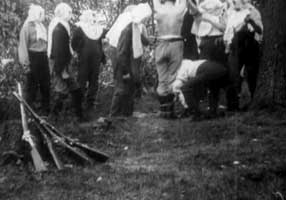 A rural setting shows a vigilante group that was active at the time in Indiana, Kentucky, Texasm & especially the southwest states, known as The White Caps (1905), who became the subject of an Owen Davis play adapted to this film.
A rural setting shows a vigilante group that was active at the time in Indiana, Kentucky, Texasm & especially the southwest states, known as The White Caps (1905), who became the subject of an Owen Davis play adapted to this film.
They resemble the Ku Klux Klan in governing structure, but their purpose wasn't racist, at least not according to this action film which gets it wrong. Here they are depicted as the moral values police, & their victims are poor whites.
The film suggests they wore pillow cases with eye-holes rather than sheet-hats so their masks were square rather than pointed. For cinematic purposes the square pillowcase masks are dramatic.
One man beats his wife -- shown in brutal detail -- so that the injured wife flees with her daughter. Soon after, members of the White Caps kidnap him, & when he escapes into the woods, they hunt him down like the Frankenstein monster.
They string him up to a tree by his arms, & tar & father him, a nightmarish sequence that comes closer to the truth of tar & feathering than do most later films, some of which assume it was just kind of funny & could be removed with turpentine. The reality was that it was a method of extreme torture & often enough slow death as it caused third-degree burns followed by infection; severe scarring marked survivors for life.
It's impossible to tell if the filmmakers approve or disapprove of this vigilantism. On the one hand the husband is so brutal, something bad deserved to happen to him. But the White Caps are so extreme in their punishement, most people would conclude they are no better than the people they punish. To great extent, the film is neutral, & just reconstructs how law was carried out in many rural regions of America.
The fact that it is left open for the viewer to approve or disapprove of the White Caps required ignorance of actual White Cap activity. Historically the White Caps were white supremacists. The White Caps of Mississippi targeted blacks. In border states they terrorized Mexican farmers & itinerant laborers as well as the Black communities that sprang up after emancipation & manumission.
They would flog, torture, & at times lynch those with whom they had disputes. The original Indiana White Caps had all sorts of excuses for their behavior but usually clan vendetta was the real basis of their attacks, akin to the Sicillian mafia.
In most rural regions the White Caps membership consisted of the lowest level of white trash but they nevertheless served the interests of rich white land owners. When deeds were granted to new settlers in western & southwestern states, it was typically the White Caps who cut fences, shot livestock, & burned houses to preserve free open rangeland for cattle tycoons.
Like most criminal gangs who stand with profound hypocrisy atop stacks of Bibles pretending to morality, they preyed not only on their so-called enemies but also upon each other.
So white-trash on white-trash violence was indeed aimed at members of their own community whose drunkenness or inability to care for their families did get them tortured much as the Porter/McCutcheon film conveys. They were also fond of assaulting women accused of adultery or prostitution or any sexual activity that captured their attention.
Sometimes they attacked "heretics" as many unusual cultic organizations had hoped to find refuge in the west & southwest, only to find lawless bigots ready to run them out of the region. But what was most common for white-against-white White Cap action was when they attacked white families & burned them out, for failing to support the racist agenda, for having sold or rented lands to Black or Mexican settlers.
It seems unlikely Porter & McCutcheon honestly knew much about the White Caps beyond whatever were the popular conceptions or misconceptions, & their own claims for themselves was that they weren't murderers but only flogged sinners. Still, even if all Porter & McCutcheon knew of them was what Boothe Tarkington described in the best-selling A Gentleman from Indiana (1899), they ought to have been less tentative in chosing sides here.
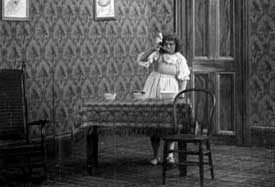 One of the cooler films by Porter & McCutcheon is an important early work for stop-motion animation.
One of the cooler films by Porter & McCutcheon is an important early work for stop-motion animation.
The Teddy Bears (1907) combines the story of "Goldilocks & the Three Bears" with the story of Teddy Roosevelt's famous hunting incident, when he spared a bear cub, giving rise to the "Teddy Bear" as a popular toy.
The latter was something Porter had previously spoofed in Terrible Teddy, the Grizzly King (1901).
The bears are represented by costumed actors. In the opening scene, rowdy Baby Bear proves rather rambunctious for Mama Bear & Papa Bear to manage, but finally they get a reign on him & drag him by an ear inside their lovely country cottage.
They all get gussied up in their Sunday best & go for a walk, Baby Bear taking one of his teddy bears with him.
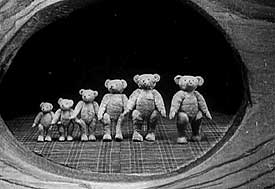 While they're gone, the thieving hellion Goldilocks breaks into their cottage, eats their food, makes fun of their family photos, then looks through a knothole into a locked room & sees a family of dancing teddy bears! While they're gone, the thieving hellion Goldilocks breaks into their cottage, eats their food, makes fun of their family photos, then looks through a knothole into a locked room & sees a family of dancing teddy bears!
The teddies seem to know she's peeping at them, as they look straight at the peep hole before they begin doing their acrobatic chorus line routine.
This bit of the film is just tremendous good fun, totally surreal & off the wall, with teddies standing on their heads, twirling on their butts, & otherwise acting in a massively silly manner.
Goldilocks tries to break into the room but can't, so she goes into the bedroom & messes up all three beds before napping in Baby Bear's bed, hugging one of Baby Bear's many teddies that was beside the bed.
The Bear famiy returns home, put on their nightclothes & start off to bed when lo & behold there's a human girl in Baby Bear's bed. Goldilocks leaps out of bed & jumps through the window, stealing one of Baby Bear's beloved teddy bears.
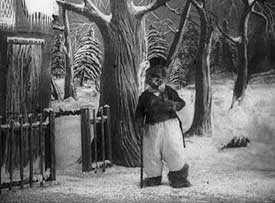 The Bears pursue the thief over the snowy countryside. After an extensive chase scene, Goldilocks encounters none other than Theodore Roosevelt on a hunt. The Bears pursue the thief over the snowy countryside. After an extensive chase scene, Goldilocks encounters none other than Theodore Roosevelt on a hunt.
Despite that Papa Bear is wearing clothes & glasses & carrying a cane, Roosevelt shoots him dead. Then Momma Bear is shot dead in her dress & apron.
The newly orphaned Baby Bear falls to his knees & begs for his life, so is put on a leash & doomed to life in captivity.
Goldilocks takes Roosevelt to the Bear's pleasant country cottage where she's permitted to steal all the remaining toy bears, while the leashed Baby Bear can do nothing more than hope to live out the day. If there's a Hell, Goldilocks is going there.
copyright © by Paghat the Ratgirl
|
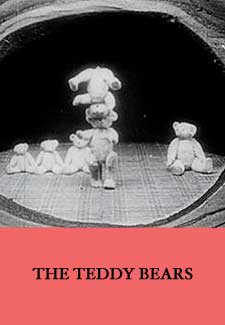

 We next see Mannie chasing after a Chinese guy with a pigtail. The dog leaps up the man's back, & latches onto the pigtail, pulling him to the ground. The boys laugh & laugh, as it's only a stinking Chinaman who's being mauled after all.
We next see Mannie chasing after a Chinese guy with a pigtail. The dog leaps up the man's back, & latches onto the pigtail, pulling him to the ground. The boys laugh & laugh, as it's only a stinking Chinaman who's being mauled after all.


 While they're gone, the thieving hellion Goldilocks breaks into their cottage, eats their food, makes fun of their family photos, then looks through a knothole into a locked room & sees a family of dancing teddy bears!
While they're gone, the thieving hellion Goldilocks breaks into their cottage, eats their food, makes fun of their family photos, then looks through a knothole into a locked room & sees a family of dancing teddy bears! The Bears pursue the thief over the snowy countryside. After an extensive chase scene, Goldilocks encounters none other than Theodore Roosevelt on a hunt.
The Bears pursue the thief over the snowy countryside. After an extensive chase scene, Goldilocks encounters none other than Theodore Roosevelt on a hunt.